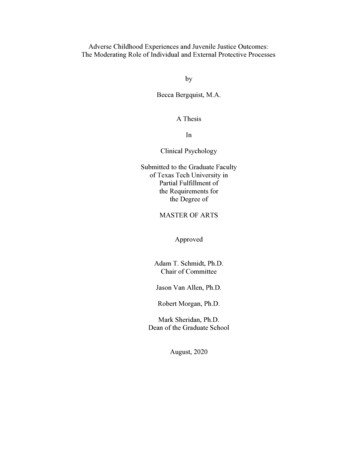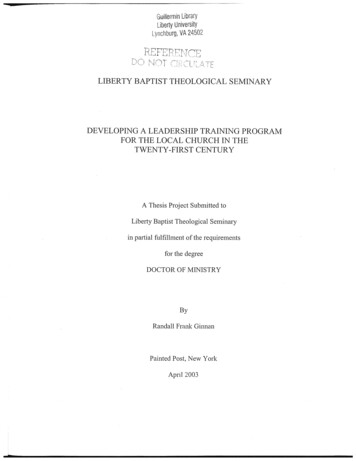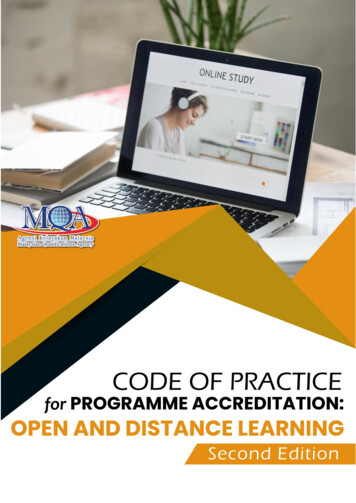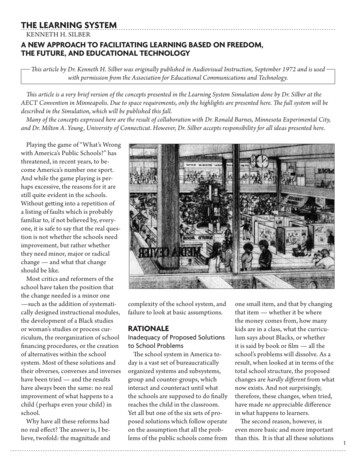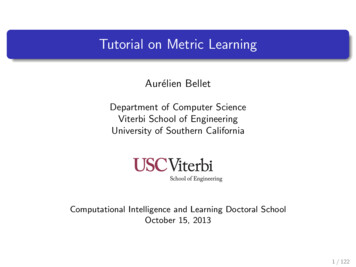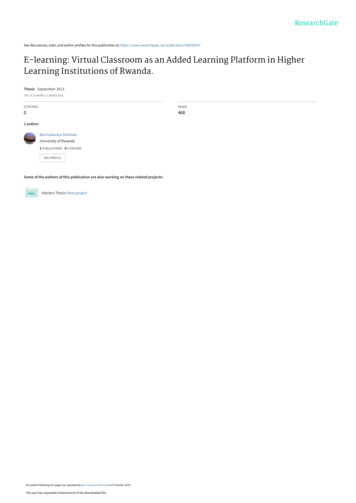
Transcription
IE-learning, experiences and future
E-learning, experiences and futureEdited bySafeeullah SoomroIn-Techintechweb.org
Published by In-TehIn-TehOlajnica 19/2, 32000 Vukovar, CroatiaAbstracting and non-profit use of the material is permitted with credit to the source. Statements andopinions expressed in the chapters are these of the individual contributors and not necessarily those ofthe editors or publisher. No responsibility is accepted for the accuracy of information contained in thepublished articles. Publisher assumes no responsibility liability for any damage or injury to persons orproperty arising out of the use of any materials, instructions, methods or ideas contained inside. Afterthis work has been published by the In-Teh, authors have the right to republish it, in whole or part, in anypublication of which they are an author or editor, and the make other personal use of the work. 2010 In-tehwww.intechweb.orgAdditional copies can be obtained from:publication@intechweb.orgFirst published April 2010Printed in IndiaTechnical Editor: Maja JakobovicCover designed by Dino SmrekarE-learning, experiences and future,Edited by Safeeullah Soomrop. cm.ISBN 978-953-307-092-6
VPrefaceBasically e-learning is new way of providing knowledge to peoples to interact with webbased systems which is need of current world. E-learning based systems received tremendouspopularity in the world since this decade. Currently most of the universities are using e-basessystems to provide interactive systems to students which can make communication fast togrow up the knowledge in every field of study. Many advantages comes to adopt e-learningsystems like paper less environment, pay less to instructors, students can access systems fromany part of world, advanced computer trainings provided at homes and access any materialusing web. In advanced countries e-learning systems play major role in an economy toproduce productive output in the industries without having paid huge amount for personalstaff that are locating physically and also provide big advantage to peoples of developedcountries who can not attend physically courses neither afford experts in a professional fields.This is big achievement of e-learning bases systems to promote education online.This book is consisting of 24 chapters which are focusing on the basic and applied researchregarding elearning systems. Authors made efforts to provide theoretical as well as practicalapproaches to solve open problems through their elite research work. This book increasesknowledge in the following topics such as e-learning, e-Government, Data mining in e-learningbased systems, LMS systems, security in elearning based systems, surveys regarding teachersto use e-learning systems, analysis of intelligent agents using e-learning, assessment methodsfor e-learning and barriers to use of effective e-learning systems in education.Basically this book is an open platform for creative discussion for future e-learning basedsystems which are essential to understand for the students, researchers, academic personalsand industry related people to enhance their capabilities to capture new ideas and providesvaluable solution to an international community.The editor and authors of this book hope that this book will provide valuable platform forthe new researchers and students who are interested to carry research in the e-learning basedsystems. Finally we are thankful to I-Tech Education and publishing organization whichprovides the best platform to integrate researchers of whole world though this publishedbook.Dr. Safeeullah SoomroYanbu University College,Kingdom of Saudi Arabia
VI
VIIContentsPreface1.E-Learning Indicators: A Multidimensional Model For PlanningDeveloping And Evaluating E-Learning Software SolutionsV001Bekim Fetaji and Majlinda Fetaji2.Barriers to Effective use of Information Technology in ScienceEducation at Yanbu Kingdom of Saudi Arabia035Abdulkarem Eid S. Al-Alwani and Safeeullah Soomro3.The Use of Multi-Agents’ Systems in e-Learning Platforms047Tomasz Marcin Orzechowski4.Quality Metrics of an Integrated E-Learning System –students’ perspective071Ksenija Klasnić, Jadranka Lasić-Lazić and Sanja Seljan5.Intelligent Interaction Support for e-Learning095Takashi Yukawa and Yoshimi Fukumura6.Supporting Technologies for Synchronous E-learning111Juan C. Granda, Christian Uría, Francisco J. Suárez and Daniel F. García7.Bayesian Agent in e-Learning129Maomi Ueno8.Data Mining for Instructional Design, Learning and Assessment147Lluís Vicent and Xavier Gumara9.A learning style – driven architecture build on open source LMS’sinfrastructure for creation of psycho-pedagogically – ‘savvy’personalized learning paths163Kerkiri Al. Tania , Paleologou Angela-M.,Konetas Dimitris and Chatzinikolaou Kostantinos10. E-learning in information accessibility of disabled assistanttechnologyChunlian Li,Yusun189
VIII11. Application of Data-Mining Technology on E-Learning MaterialRecommendation213Feng-Jung Liu and Bai-Jiun Shih12. Loosely-Tied Distributed Architecture for Highly ScalableE-Learning System229Gierłowski and Nowicki13. Evolution of Collaborative Learning Environments basedon Desktop Computer to Mobile Computing: A Model-Based Approach261Ana I. Molina, William J. Giraldo, Francisco Jurado,Miguel A. Redondo and Manuel Ortega14. From the discovery of students access patterns in e-learningincluding web 2.0 resources to the prediction and enhancementof students outcome275Raquel Hijón-Neira and Ángel Velázquez-Iturbide15. Dependable e-learning systems295Ali Al-Dahoud, Marek Woda and Tomasz Walkowiak16. Ontology-driven Annotation and Access of Educational VideoData in E-learning305Aijuan Dong, Honglin Li and Baoying Wang17. When a robot turns into a totem: The RoboBeggar case327Gaetano La Russa, Erkki Sutinen and Johannes C. Cronje18. Virtual patients as a practical realisation of the e-learning ideain medicine345Andrzej A. Kononowicz and Inga Hege19. Data Warehouse Technology and Application in Data Centre Designfor E-government371Xuanzi Hu20. The Emergence of the Intelligent Government in the Second Society385Dennis de Kool and Johan van Wamelen21. A Lightweight SOA-based Collaboration Framework for EuropeanPublic Sector397Adomas Svirskas, Jelena Isačenkova and Refik Molva22. Spatial Aided Decision-making System for E-Government413Liang WANG, Rong ZHAO, Bin LI, Jiping LIU and Qingpu ZHANG23. Evaluating Local E-Government: A Comparative Study of Greek PrefectureWebsitesProdromos Yannas and Georgios Lappas441
E-Learning Indicators: A Multidimensional ModelFor Planning Developing And Evaluating E-Learning Software Solutions1X1E-Learning Indicators: A MultidimensionalModel For Planning Developing And EvaluatingE-Learning Software Solutions1, 2 South1BekimFetaji and 2Majlinda FetajiEast European University, (Computer Sciences Faculty)Macedonia1. IntroductionMany current e-learning initiatives follow the “one-size-fits-all” approach just offering sometype of Learning Management System (LMS) to learners or Learning Content ManagementSystem (LCMS). Typically, this approach is related to lack of knowledge of the learneraudience or factors influencing that audience and e-learning project overall and thereforefail to provide satisfactory support in the decision making process (Fetaji, 2007a).In order to address this issue, an approach dealing with e-learning indicators is proposed,assessed, measured and evaluated. The proposed E-learning Indicators Methodologyenables successful planning, comparison and evaluation of different e-learning projects. Itrepresents an empirical methodology that gives concrete results expressed through numbersthat could be analysed and later used to compare and conclude its e-learning efficiency.With the application of this methodology in e-learning projects it is more likely to achievebetter results and higher efficiency as well as higher Return on Investment ROI.The purpose of e-learning indicators was to raise the awareness of the factors influencing elearning project in order to identify the nature of obstacles being faced by e-learners. Thisresearch argues that if such obstacles could be recognized early in the process of planningand development of e-learning initiatives then the actions that remedy the obstacles can betaken on time. We believe that the absence of appropriate on-time actions is one of the mainreasons for the current unsatisfactory results in many e-learning projects.The e-learning indicators approach is a multidimensional model used in planning,developing, evaluating, and improving an e-learning initiative. Thus, the model comprisese-learning projects as iterative development processes where at each iteration stepappropriate actions to improve the initiative outcomes can be taken. The iteration steps ofthis development process include: Planning phase with the initial measurement of e-learning indicators. The obtainedresults influence all the other phases. Design phase where (group or so called “collective”) personalisation issues andpedagogical and instructional techniques and aspects are addressed.
2E-learning, experiences and futureImplementation phase where a number of e-learning experiments are conductedbased on the results from the previous phases. Evaluation phase to obtain precise results of the initiative outcomes. Analysis phase where guidelines and recommendations are written down.The proposed model defines 18 indicators that were practically applied in a number of casestudies including their application with Angel LMS and a number of self developed andimplemented e-learning interactive tools.E-learning indicators have been defined with help of different focus groups, realisedliterature review and a web based survey of academic staff and students in the frameworkof South East European University. In addition, the approach was revised closely withexperts in the field during participation in several research projects (mentioned inacknowledgement).The experiences from these projects show that a more successful e-learning is not possibleonly if a generic approach or generic guidelines for the learners are applied. Rather,individual learning services are needed in supporting learners according to their personalpreference profile.However, although not the focus of the research because of the interconnection with theabove identified issues several projects and research initiatives that deal withpersonalization have been shortly reviewed. The reviewed projects are the OPen AdaptiveLearning Environment (OPAL), (Dagger, et al 2002) and ADELE-Adaptive e-Learning withEye Tracking (Mödritscher, et al 2006). The OPAL research shows personalization asdifficult to achieve and “ are often expensive, both from a time and financial perspective,to develop and maintain.” (Dagger, et al 2002). Therefore, a conclusion is drown that learnerpersonalisation should not bee addressed at to finely grained level. Typically,personalisation at that starting level is not practical based on the findings of OPAL project(Dagger, et al 2002) and since it has too include all of those learners preferences that changeeach time the learner uses the system clearly does not represent a constant factor that can beaddressed (Fetaji, 2007g). Instead, a recommendation is to use the defined approach with elearning indicators as starting point when developing an e-learning initiative. Then after themeasurements the learners are divided into groups so called ”collectives” (in Universitiesthese are the departmental levels) were personalisation is offered to the specifics of thecollectives majority primarily based on learning style categorization and type of learnerthey are (indicator 4, 4). We have adopted the Felder-Silverman model for learning stylecategorization (Felder, 1993). After that learner personalisation can be designed and offeredtailored to each collective (Fetaji, 2007g). Furthermore, based on the measurements of thesee-learning indicators a design of a sustainable e-learning initiative can be supported. Each elearning initiative is unique and involves specifics that can not be taken under considerationin the form of “one-size-fits-all” solution.However evaluating e-learning indicators in the planning phase is only the first step in moresuccessful e-learning. E-learning indicators can be used in other phases as well in particularin evaluating different e-learning initiatives in conjunction with ELUAT methodology toassess e-learning effectiveness. Comparison of different projects can be realised comparinge-learning indicators measurements in conjunction with the evaluated e-learningeffectiveness (how effective they have shown measured using the ELUAT methodology)(Fetaji, 2007g).
3. The Use of Multi-Agents' Systems in e-Learning Platforms 047 Tomasz Marcin Orzechowski 4. Quality Metrics of an Integrated E-Learning System - students' perspective 071 Ksenija Klasnić, Jadranka Lasić-Lazić and Sanja Seljan 5. Intelligent Interaction Support for e-Learning 095 Takashi Yukawa and Yoshimi Fukumura 6.
